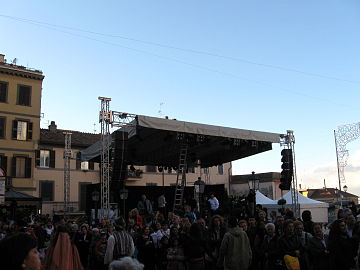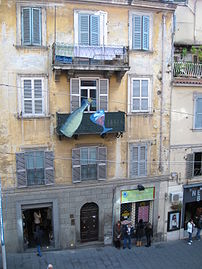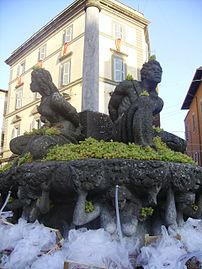Marino Wine Festival
The wine festival Marino ( Italian Sagra dell'Uva di Marino ) is an Italian festival in the city of Marino near Rome . The celebrations take place annually on the first weekend in October. They start on Thursday and end on Monday with the so-called Sagretta , the little festival.
history
The festival has its origins in both religious and historical events. For the first time it was held from September 11th to October 10th 1904 and called "Feste Castromenie". In 1924 this idea was taken up again and the festival has been held annually ever since. In its current form, it was initiated in 1925 by a poet from Rome, Leone Ciprelli (1873–1953), whose parents came from Marino. The special thing about the wine festival in Marino are the fountains from which the wine flows - unique in Italy .
Historical origin
Even in Roman times, wine production was very important for the inhabitants of Marino and the surrounding cultivation area "Castelli Romani". It is also known that October festivities were held in ancient Rome. Even in the Middle Ages, winemaking was an important source of income for the local economy.
Religious origin
The roots of this festival are also religious. On October 7, 1571, the Holy League fought against the Turks in Lepanto and was victorious over them. Marcantonio Colonna , lord of Marino, was one of the army leaders. At the end of the war, on November 4th, 1571, he returned to Marino, where his family lived. The patron saint of the battle was the Madonna of the Holy Rosary , who three days later was proclaimed by Pope Pius V as the patron saint of the Papal States. He also ordered that a festival in honor of the Mother of God be organized in every city in what was then Vatican State. A Turkish protective shield from the naval battle of Lepanto is still kept in the Basilica of Saint Barnaba in Marino. In 1924 the wine festival was held on the first Sunday in October.
Development since 1925
The main attraction is the “miracle fountain”, from which wine flows during the festivities and is then fed into the pipes that are otherwise filled with water. Leone Ciprelli also hosted a horse race with an impressive lighting system and a parade with allegorical floats. The first musical poetry competition was also organized in 1926. The president of the jury was the famous Roman poet Trilussa . A historical parade has also been held since 1929 to commemorate the return of Marcantonio Colonna after the Lepanto victory. All these customs, with the exception of horse races, are still part of the festival program today. During the Second World War, the festival was politically abused by the fascist regime, so that after the end of the war, many residents were no longer interested in a revival. But Ciprelli was able to convince them to revive the festival.
Highlights of the festival
On Saturday afternoon, the news of Marcantonio Colonna's return after the victory of Lepanto will be remembered with a historic parade attended by messengers on horseback, trumpeters and flag throwers. The first part of Sunday has a sacred character. In the morning there is a procession to honor the Madonna of the Holy Rosary : her statue is traditionally carried on her back. Holy mass is read at the end of the procession. Children offer the Madonna blessed grapes and wine on behalf of the whole population and ask for protection for the vineyards. In the afternoon the second part begins, a pagan ceremony: the streets decorated with grapes are teeming with people. A historical parade represents the triumphant entry of Marcantonio Colonna and his army into the city as well as the meeting with his family who stayed in Marino during the naval battle of Lepanto . The roles of Marcantonio Colonna and his wife Felice Orsini are interpreted by actors. Also noteworthy are the historical costumes that are put on for the occasion. At sunset, the “miracle” occurs: wine flows from the city's fountains. A parade with allegorical floats also leads through the city. The Sagretta , the so-called little festival that takes place on Monday, was only introduced after World War II. It is a scaled-down version of the festival, in which the pagan cults are represented again (the historical parade, the allegorical floats and the miracle of wine). The Sagretta is primarily the festival of the people of Marino. That is why it is also called the Sagra dei Marinesi .
Others
At the 2006 wine festival, the German composer Hans Werner Henze , who declared Marino his adopted home, was awarded honorary citizenship.
Since 2004, Marino is the Greek town of Nafpaktos , the former Lepanto in a twinning connected.
literature
- Comune di Marino - Associazione “Pro Loco” (1999): “Marino”, Ariccia (Rm) Cover snc
- Onorati, Ugo (2004): La Sagra dell'Uva di Marino - “Aspetti, vicende, curiosità di una delle più antiche e popolari festivals d'Italia”, Ciampino (Rm), AGC Arti Grafiche Ciampino srl
Web links
- (IT) Municipality of Marino
- (IT) Photos from the wine festival
- (IT) Tourist information
- (IT) City map of Marino and further information
Coordinates: 41 ° 46 ′ 11.9 " N , 12 ° 39 ′ 33.7" E




